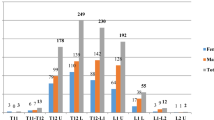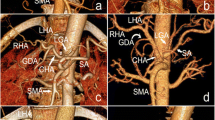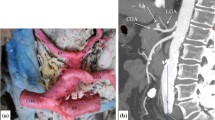Summary
The angiographic visualization of the pancreatic arteries, their numerical variations, origins, course and anastomoses, as well as their mean diameter by age-group (20–40, 41–60, >60 years) have been quantitatively investigated by selective celiac angiography in 72 patients without pancreatic disease. Visualization of the various arteries was achieved in a high percentage of cases except for the inferior pancreaticoduodenal arches, due to undervaluation of this vessel by celiac angiography. Confirmation of the great variability of the origin and anastomoses of the dorsal and transverse pancreatic arteries was obtained and possible embryologic reasons and clinical implications of this fact are discussed. Furthermore, a high percentage of multiple (quadruple or more) pancreatica magna and caudae pancreatis arteries has been observed and a functional role of this peculiar arrangement is suggested, Finally, no statistically significant differences were found in the diameter of any artery due to increasing age probably reflecting maintained neural perivascular control of the pancreatic vessels in the elderly. Satisfactory sensitivity of the angiographic method has been found with respect to the evaluation of visualization and anastomoses of the pancreatic arteries in vivo.
Résumé
Une étude angiographique a permis d'étudier les variations du nombre, de l'origine, du trajet et des anastomoses des artères du pancréas ainsi que leur diamètre moyen en fonction des groupes d'âges (20–40, 40–60 et plus de 60 ans); cette étude quantitative a été effectuée par artériographie cœliaque sélective chez 72 patients ne présentant aucune lésion pancréatique. Les différentes artères du pancréas ont bien été visualisées dans la majorité des cas, excepté l'arcade pancréatico-duodénale inférieure qui est mal explorée par l'angiographie cœliaque. Ce travail confirme les grandes variations d'origine et d'anastomoses des artères pancréatiques transverse (artère pancréatique inférieure) et dorsale et permet de proposer des explications embryologiques et des applications cliniques. De plus, un pourcentage important d'artères multiples (4 ou plus) et d'artères de la queue du pancréas a été noté, permettant d'évoquer le rôle fonctionnel de cette distribution particulière. Enfin il n'a pas été trouvé de différence significative du diamètre des artères en fonction de l'âge, ce qui est probablement dû au maintien d'un contrôle nerveux périvasculaire réflexe des vaisseaux pancréatiques chez les sujets âgés. La méthode angiographique a une sensibilité satisfaisante qui permet une bonne visualisation des artères du pancréas et de leurs anastomoses in vivo.
Similar content being viewed by others
References
Abrams RM (1983) Angiography, 3rd ed. Little brown, Boston
Bolognese A, Di Giorgio A, Stipa V (1979) Arterial vascularization of the pancreas, anatomical findings by means of vascular injection of plastic material. Surg 9: 346–351
Bouchet Y, Martin R (1961) Considerations sur l'artère pancreatica magna ou pancreatique dorsale. CR Assoc Anat 42: 174–180
Brandt G (1984) Die Gefässarchitektur des humanen kaudalen Pankreas-Segmentes. Anat Anz 157: 73–81
Calas F, Martin R, Bouchet Y, Polliak D (1955) Les artères de la tête du pancréas. CR Assoc Anat 42: 362–367
Calas F, Martin R (1956) Origine et trajet de l'artère pancreatica magna. Arch Anat Pathol 4: 17–18
Chérigié E, Mellière D, Bennet J, Doyon D, Chenard JC (1967) Anatomie radiologique de la vascularization du pancréas. J Radiol Electrol 48: 346–352
Falconer CWA, Griffiths E (1950) The anatomy of the blood vessels in the region of the pancreas. Br J Surg 37: 334–344
Fontaine C, Francke JP, Ribet M, Libersa C (1981) Contribution à l'étude de la vascularisation artérielle de la queue du pancréas. Bull Assoc Anat (Nancy) 65: 93–100
Gliedman ML, Tellis V, Soberman R, Rifkin H, Freed SZ, Veith FJ (1975) The clinical use of steroids in pancreatic transplantation. Transplant Proc 7: 93–98
Groth CG, Lundren G, Arner P, Collste H, Hardstedt C, Lewander R, Ostman J (1976) Rejection of isolated pancreatic allografts in patients with diabetes. Surg Gynecol Obstet 143: 933–940
Huffman L, Hedge GA (1986) Effects of vasoactive intestinal peptide on thyroid blood flow and circulating thyroid hormone levels in the rat. Endocrinology 118: 550–557
Hogle HH, Reemtsma K (1978) Pancreatic autotransplantation following resection. Surgery 83: 359–360
Karp W, Lunderquist A, Tylen U, Ishe I (1980) Angiography and ultrasound examination in the evaluation of pancreatic lesions. Acta Radiol 21: 167–176
Kivisaari L (1979) Microvasculature of the human pancreas. A microangiographic study. Scand J Gastroenterol 14: 683–687
Mellière D (1968) Variations des artères hépatiques et du carrefour pancréatique. J Chir (Paris) 95: 5–42
Michels NA (1955) Blood supply and anatomy of the upper abdominal organs. Pitman Med Pub, London
Moossa AR (1984) Current concepts: diagnostic tests and procedures in acute pancreatitis. N Engl J Med 311: 639–643
Nomina Anatomica (1980) 5th ed. Williams and Wilkins, Baltimore London
Papadatos D (1981) Some anatomo-radiological observations concerning the changes in thyroid arteries which occur with senility. Anat Anz 150: 212–225
Pitzorno M (1920) Morfologia delle arterie del pancreas. Arch Ital Anat Embriol 18: 1–48
Re G, Casali A, Cavalli D, Guida G, Toni R, Bolondi L, Cavalli G (1985) Morphological bases of splenic circulation in congestive splenomegaly. Haematologica 70: 283–290
Rosch J, Bret J (1965) Arteriography of the pancreas. Am J Rontgen 94: 182–193
Ross B, Fox M (1981) Blood supply of the distal part of the human pancreas. A study with segmental pancreatic transplantation in view. Transplantation 31: 134–136
Rouanet JP, Bruel JM, Lamarque JL, Djoukhadar A (1979) Aspect artériographique des principaux circuits artériels anatomo-physiologiques de suppléance digestive. Anat Clin 1: 375–382
Steel RGD (1960) Principles and procedures of statistics. Mc-Graw-Hill, New York
Tandler J (1903) Zur Entwicklungsgeschichte der menschlichen Dermarterien. Verh Anat Ges 23: 132–134
Thomford NR, Chandnani PC, Taha AM, Chablani VN, Busnardo AC (1986) Anatomic characteristics of the pancreatic arteries, radiologic observations and their clinical significance. Am J Surg 151: 690–693
Toni R, Favero L, Bolzani R, Roversi R, Vezzadini P (1985) Further observations on the anatomical variation in the arteries of the human pancreas. IRCS Med Sei 13: 605–606
Toni R, Mosca S, Favero L, Ricci S, Roversi R, Cocco L, Vezzadini P, Toni G (1987 a) Anatomo-clinical observations on some morphologic parameters of the adrenal arteries and age-related changes of their diameter studied bay angiography. Abstracts of the Eighth European Anatomical Congress. Acta Anat (Basel) 130: 92
Toni R, Favero L, Mosca S, Ricci S, Roversi R, Cocco L, Vezzadini P, Toni G (1987 b) Angiography versus resin corrosion casts of the pancreatic arteries: anatomo-clinical considerations. Abstracts of the 8th European Anatomical Congress. Acta Anat (Basel) 130: 92
Traeger J, Dubernard JM, Touraine JL, Neyra P, Malik MC, Pelissard C, Ruitton A (1979) Pancreatic transplantation in man: a new method of pancreas preparation and results on diabetes correction. Transplant Proc 9: 331–335
Uddman R, Edvinsson L, Ekblad E, Hakanson R, Sundler F (1986) Calcitonin gene-related peptide (CGRP): perivascular distribution and vasodilatory effects. Regul Pept 15: 1–23
Vujic I, Anderson MC, Meredith HC, Cullom JW (1980) Successful embolization of the dorsal pancreatic artery to control massive upper gastrointestinal hemorrhage. Am Surg 46: 184–186
Woodburne RT, Olsen LL (1951) The arteries of the pancreas. Anat Rec 111: 255–270
Author information
Authors and Affiliations
Rights and permissions
About this article
Cite this article
Toni, R., Favero, L., Mosca, S. et al. Quantitative clinical anatomy of the pancreatic arteries studied by selective celiac angiography. Surg Radiol Anat 10, 53–60 (1988). https://doi.org/10.1007/BF02094071
Received:
Accepted:
Issue Date:
DOI: https://doi.org/10.1007/BF02094071




